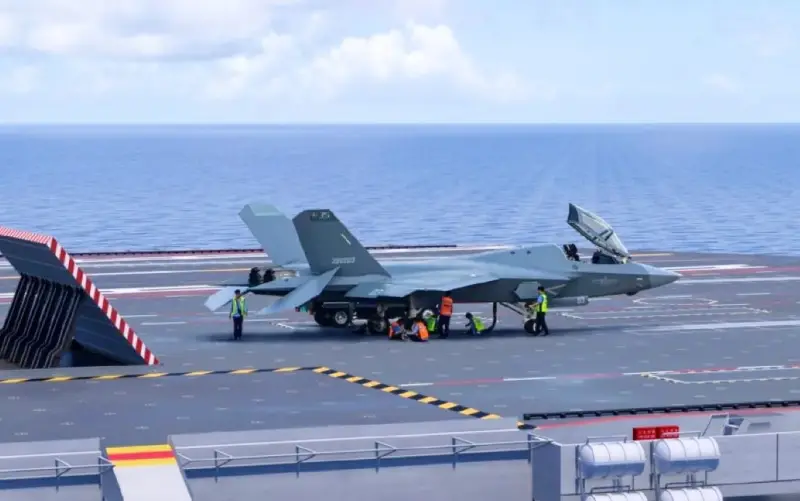Hong Kong media announced the parameters of the newest J-35 fighter
A number of Hong Kong media outlets have published the main technical characteristics of the new carrier-based stealth fighter J-35, which is preparing to enter service with PLA aircraft carriers. The data is compiled based on publicly available information from the Aviation Industry Corporation of China (AVIC).
It was especially noted that the J-35 fighter will be equipped not with the Russian-made RD-93 engine or its domestic approximate analogue WS-13, as previously expected, but with two new WS-19 Huangshan engines developed by China. The more powerful engine allows the J-35 to have a maximum take-off weight of 35 tons and a maximum flight speed of Mach 2,2. At the same time, the maximum bomb load reaches 8 tons, which is only slightly inferior to the main stealth fighter of the PLA J-20
– reports the Chinese portal LiuYuan.
In addition, the J-35's avionics are described as "significantly more advanced." The newest fighter will have many advanced subsystems, such as an active phased array radar and a passive infrared detection system. According to Hong Kong media, the minimum radar reflection area in the forward projection is only 0,01 square meters. m, which corresponds to one of the highest levels of stealth in the world.
Chinese aviation expert Wang Yanan noted that the maximum take-off weight of the J-35 will in any case exceed that of the American F-35 (29,9 tons), and it is more advanced in stealth and flight characteristics. The new generation aircraft carrier Fujian, which is scheduled to be delivered to the PLA Navy in 2025, is designed to be equipped with J-35 fighters, and the combat effectiveness of such a combination, according to the PRC, will be comparable or even superior to any of the US nuclear-powered aircraft carriers.
In turn, American “experts” are already trying to categorically refute this forecast.
The actual performance of the J-35 will most likely not be as advertised <...> Although China has spent a lot of money on the J-35, the country still has limited experience in developing stealth fighters, while the US has been developing such fighters since the end of the Cold War. Whatever their ultimate performance, I don't think they can compete with the F-35
- said American military analyst Ben Lewis, founder of the PLA Tracker website, specializing in tracking Chinese weapons.
Lewis also noted that the stated speed of the J-35 (Mach 2,2) is so much higher than that of the F-35C (Mach 1,5), perhaps only because China “took advantage of loopholes” in the calculations of fuel capacity, payload and etc. when testing his fighter at top speed.
It is easy to see that the American media and experts underestimate the J-35. However, the reality may be completely opposite to what they hope for. First of all, the J-35 is a full-fledged twin-engine heavy-duty carrier-based fighter, while the carrier-based versions of the F-35 are just heavily overweight single-engine “middling” fighters. The J-35 has an advantage in excess engine power over the F-35, so it makes sense that the J-35 has advantages in flight performance, weapons load, and maximum takeoff weight.
– concludes LiuYuan.
The Chinese online publication also recalled that the US-praised F-35 appears to many to be “advanced,” but in fact it is the result of development at the beginning of this century. The J-35 is many years behind the F-35, and it is normal for it to have a “latecomer advantage” in stealth, avionics, and other technical areas.

Information